No Amount Of ‘Normal Matter’ Can Eliminate The Need For Dark Matter

Whatever’s lurking out there, it isn’t all, or even mostly, normal matter.
When it comes to the Universe, it’s only natural to wonder what, exactly, it is that makes everything up. While some of it is matter like us — things assembled out of atoms, which in turn themselves are made of subatomic particles like protons, neutrons, and electrons — there’s overwhelming evidence that the majority of material that’s out there is fundamentally different from what it is that we’re made out of. In fact, when we sum up every type of known fundamental quantum, everything that’s made out of particles of the Standard Model, we come up tremendously short.
Not only is the Universe not made out of the same stuff we are, but it’s not made out of anything that we’ve ever directly detected. In fact, to an incredible degree of both precision and certainty, we know precisely how much of the Universe, in terms of total energy, is made up of everything whose properties are definitively known: just 5%. The rest of the Universe must be some form of energy that has, thus far, evaded direct detection, with 68% being dark energy and 27% dark matter.
On the surface, it seems reasonable to wonder whether what we’re calling dark matter might not be real, but rather might be made out of some type of known, normal matter that simply hasn’t yet been identified. But a deeper analysis reveals that isn’t possible at all, and we have the evidence to prove it. Here’s how we know that, whatever dark matter is, it isn’t simply “normal matter” that’s dark.

One of the best things about the laws of physics is this: if you can give a physicist the initial conditions that a system starts off with, the laws of physics alone will allow you to predict what sort of outcomes you’re going to wind up with. If you start with a distribution of masses and the law of gravity, physics will tell you how those masses will evolve and what types of structures will form. If you start with a distribution of electric charges and Maxwell’s equations, physics will tell you what type of electric and magnetic fields will arise, as well as the types of charged currents that will get created.
And if you start off with a system of hot, interacting quantum particles, the laws of physics will tell you — albeit probabilistically — what types of bound and free states are likely to exist, and with what distribution, after a certain amount of time has passed. Given that we know the laws that govern the Universe in the form of the Standard Model and General Relativity, and we’ve now completed the Standard Model in terms of the known, measured, and directly detected fundamental quanta (particles and antiparticles alike), we can do precisely this for even the entire Universe itself.
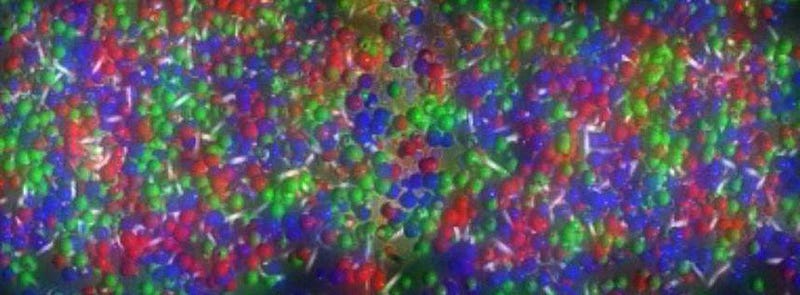
In the very early stages of the hot Big Bang, we know that the Universe must have been filled with all the various types of particles and antiparticles that it’s quantum mechanically possible to create. Anytime you have a sufficiently energetic collision between two fundamental particles — precisely what we routinely cause at particle colliders like the Large Hadron Collider at CERN — there’s a non-zero probability that you’ll spontaneously create a brand new particle-antiparticle pair. As long as there’s enough free, available energy to make new particles out of while still conserving the overall energy and momentum of the system, Einstein’s E = mc² will enable you to pretty much create anything.
In the early Universe, we know that things got hotter and denser than they ever have at the Large Hadron Collider, or at any particle accelerator or detector we’ve ever built on Earth. With incredibly large amounts of matter and energy present at incredibly high densities, the energy in the early stages of the hot Big Bang became distributed among all the known species of particles and antiparticles in specific ratios, as dictated by the laws of physics. There may have been other, novel, not-yet-discovered particles and antiparticles present as well, but, at the very least, in the earliest, hottest stages, all of the known particles existed in great abundance as the Universe expanded and cooled.
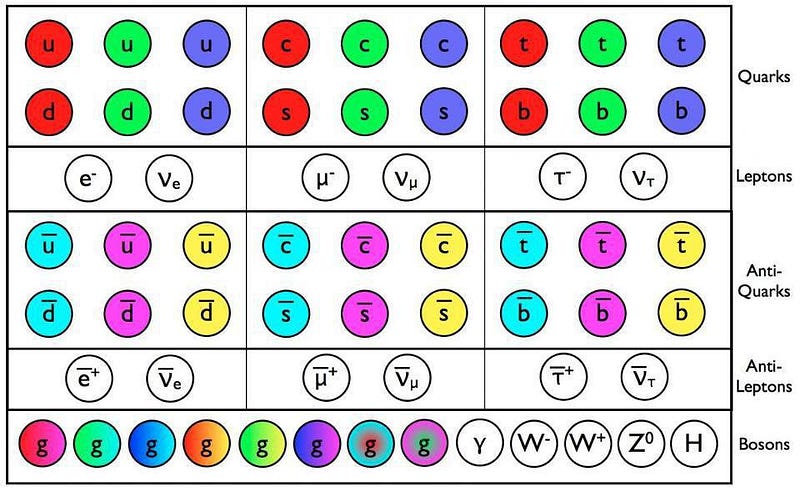
In these early stages, every set of particle-antiparticle pairs has both a creation rate and an annihilation rate. In the earliest, hottest stage, they balance, and that balance point determines the abundance of each species of particle and antiparticle. You make particle-antiparticle pairs when you have collisions with enough energy to allow creation via E = mc², and you destroy them when they find one another and annihilate away.
As the Universe expands and cools, however, it loses energy. When the temperature of the Universe drops below a certain, critical threshold — a threshold set by the rest mass of each particle — fewer and fewer collisions occur that have enough energy to allow for creation to be a possibility. However, not only do these particle-antiparticle pairs continue to be quite efficient at finding one another and annihilating away, but unless the particle is fundamentally stable, it will begin decaying away as well. For each and every particle in the Standard Model, they begin annihilating and decaying away in a predictable order and a predictable, understandable fashion.

When the Universe is a few picoseconds old, top quarks and antiquarks stop being created, and quickly decay away. The electroweak symmetry breaks at just about the same time, giving rise to the laws of physics as we experience them, not as they were at ultra-high energies. A few picoseconds later, the Higgs bosons, as well as the Z-boson and then the charged W-bosons, all decay away as well. When we start counting time in nanoseconds, bottom quarks and antiquarks, charm quarks and antiquarks, and tau and anti-tau leptons disappear from the Universe as well.
When the Universe reaches a few microseconds in age, a new threshold gets crossed: the temperatures and densities have now dropped low enough that confinement occurs, and what was previously a quark-gluon plasma now becomes full of bound states. Hadrons, like baryons, anti-baryons, and mesons, form in copious numbers. As things continue to expand and cool, particles containing strange quarks and antiquarks decay away, as do all the remaining mesons and muons.
Finally, when the Universe is now milliseconds old, protons and neutrons annihilate away with anti-protons and anti-neutrons. At this point, all we are certain we have left are photons, electrons, positrons, neutrinos, and anti-neutrinos, with a tiny amount of leftover protons and neutrons — about 1 part in 1 billion — that somehow existed in excess of their antimatter counterparts.
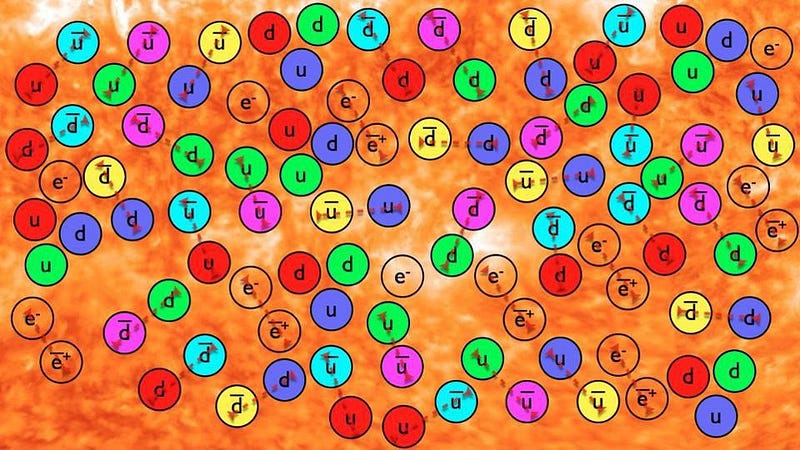
Yes, there might have been dark matter and dark energy present as well, even at these early stages. There might have been additional fundamental particles present; there might have been new fields or interactions or couplings or symmetries; there might have been any number of “extra” things that were copious early on, and that remained for a substantial time, perhaps even persisting until today. What’s wonderful about this aspect of the hot Big Bang is that it’s not only accommodating to these scenarios, but that the physics that occurs for this component of the story is virtually unchanged irrespective of what else might abound.
Before the Universe reaches the age of “1 second” after the Big Bang, the protons and neutrons that remain are free to interact with all of the remaining, more numerous particles. As they do, four interactions become important to examine in detail.
- proton + antineutrino → neutron + positron,
- proton + electron → neutron + neutrino,
- neutron + neutrino → proton + electron,
- neutron + positron → proton + antineutrino.
When the Universe remains very hot, these interactions occur at equal rates, and the Universe is split 50/50 between protons and neutrons. But as the Universe expands and cools, things begin to change all together.
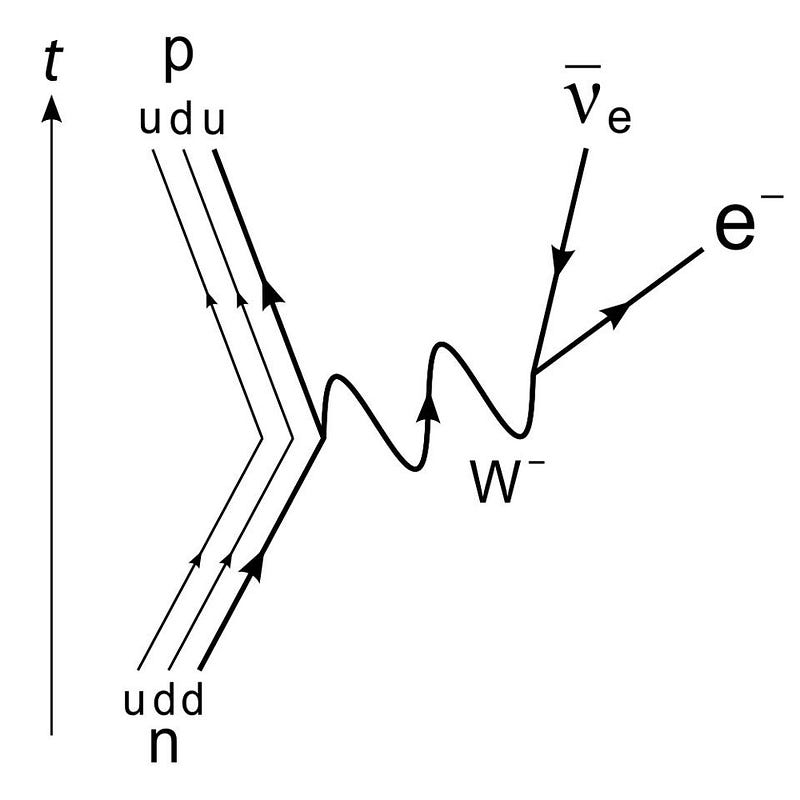
You have to remember that neutrons are just a little, tiny bit heavier than protons: 0.14% more massive. If you want to collide a proton either with an antineutrino or an electron to create a neutron (plus other stuff), your collision needs to have a certain extra amount of energy to make it possible. As the Universe begins to cool, that critical amount of energy gets harder and harder to come by. As a result, it becomes easier for neutrons to combine with neutrinos or positrons to convert into protons than it is for protons to combine with either electrons or antineutrinos to make neutrons. The balance starts to shift away from proton-neutron equality to favor protons.
At about 1 second after the Big Bang, neutrinos and anti-neutrinos freeze out, as the weak interaction — which governs neutrino interactions with all forms of matter — becomes insignificant at these low energies and temperatures. Protons and neutrons continue to interconvert, but less efficiently, and soon after, no more than 3 seconds after the Big Bang, it becomes too cold to spontaneously create electron-positrons pairs. After a brief period of massive annihilation, creating even more photons, the excess electrons annihilate away with the positrons.
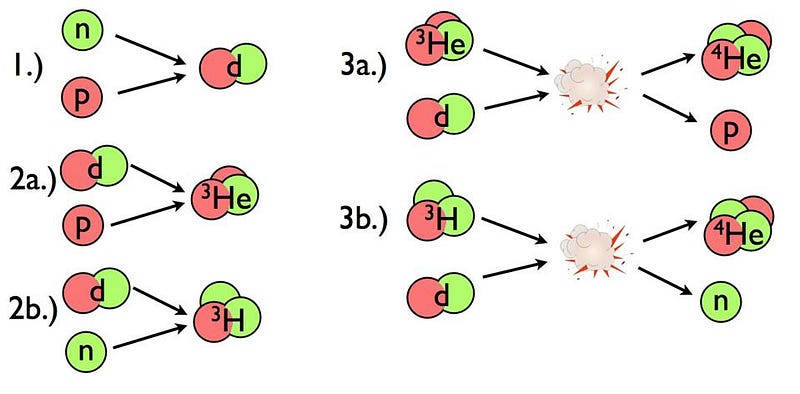
At this point, what’s left is a Universe that’s filled with two backgrounds of radiation: a photon background, which eventually becomes the cosmic microwave background, and a neutrino/antineutrino background, which still persists but has only been detected indirectly, and has a temperature that’s 71.4% of the photon background’s. Interspersed with that are a small number of protons and neutrons, with some electrons as well: equal in number to the number of protons, to keep the Universe electrically neutral. At this point, about 3 seconds after the start of the hot Big Bang, the normal matter in the Universe is about 72% protons and 28% neutrons.
Now, these protons and neutrons would love to fuse together, but they can’t just yet. As soon as they do, forming a deuterium nucleus, a photon — which, remember, outnumber protons and neutrons by somewhere around a billion-to-one — comes in and strikes it. At just ~3 seconds after the hot Big Bang, these photons are so energetic that they immediately blast these nuclei apart. You have to wait for the Universe to expand and cool sufficiently before you can pass this “deuterium bottleneck” and form the light nuclei, a waiting game that takes a little under 4 minutes, total.
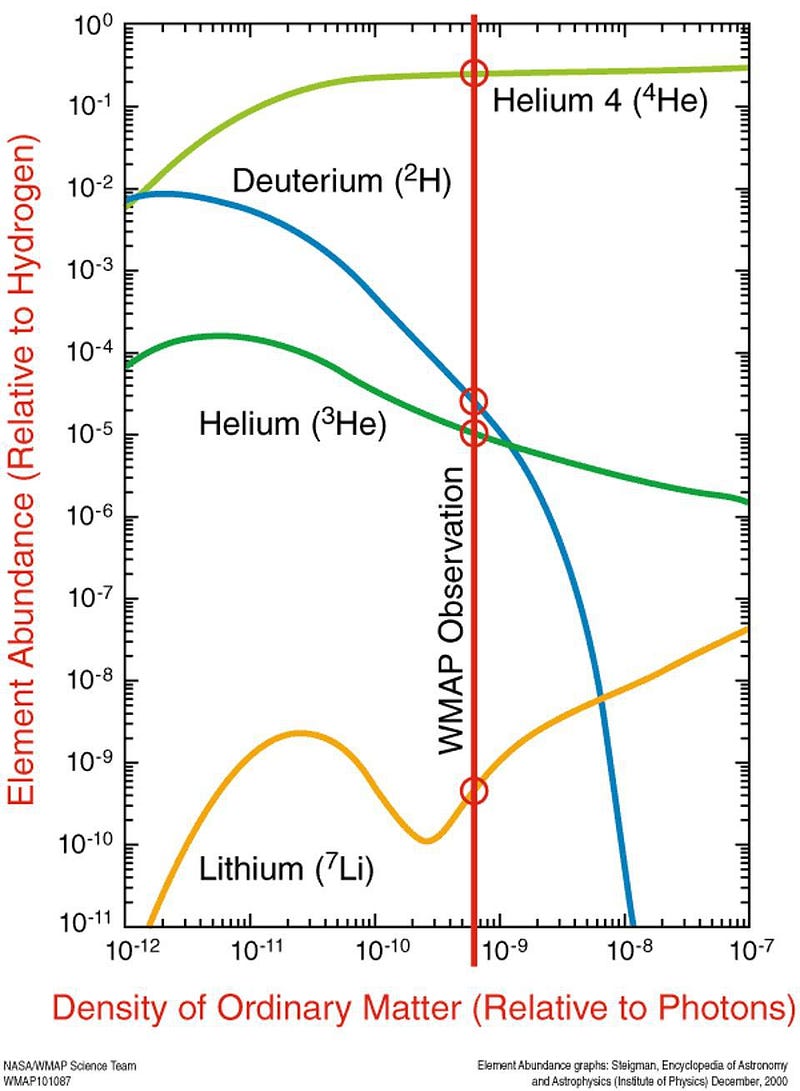
During that time, a fraction of the free neutrons decay, shifting the balance from 72/28 in favor of protons to an even more significant difference: 75/25. You wind up creating the lightest elements and their isotopes: hydrogen, deuterium, helium-3, helium-4, and lithium-7. Today, we can not only calculate what the abundances ought to be — which depends solely on one parameter, the baryon-to-photon ratio — but measure them as well. (Baryons, today, are the total number of protons and neutrons, combined.) Our Universe, which winds up with ~25% helium-4, ~0.01% deuterium, ~0.01% helium-3, and ~0.0000001% lithium-7, before any stars are formed, showcases a spectacular agreement between theory and observation.
But this is the answer! Remember, we wanted to know the answer to the question of, “how much normal matter, total, is there in the Universe?” We can exquisitely measure the density of photons left over from the hot Big Bang: there are 411 of them per cubic centimeter of space. If we know the baryon-to-photon ratio, which we can conclude from precisely this line of thought, we know how much normal matter there is, total, in the Universe. That’s exactly why we know, if we could measure, locate, and add up all the forms of normal matter in the Universe:
- stars,
- gas,
- dust,
- plasmas,
- black holes,
- planets,
- brown dwarfs,
- and anything else you can imagine,
it adds up to a specific number: 5% of the total amount of energy that must be present.
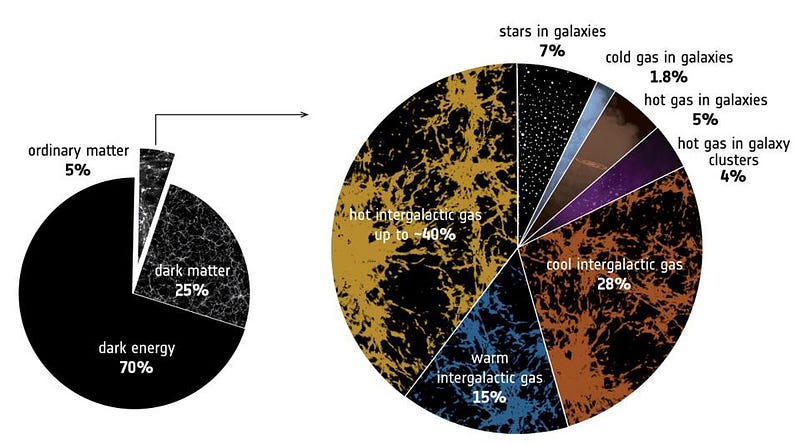
The science of nuclear physics, the measured abundances of the light elements immediately following the Big Bang, and the properties of the early Universe all combine to teach us precisely how much normal matter there is in the Universe overall. Yes, we haven’t found it all; yes, most of it isn’t in the form of stars; yes, much of it doesn’t emit or absorb light in any substantial amounts, and is therefore “dark.” But no matter how much of it we find, and no matter where we find it, it won’t put a dent in the amount of dark matter that we need.
From the full suite of cosmic observations that we have, 32% of the Universe, total, needs to be some form of matter with a non-zero rest mass. Only 5%, total, is allowed to be normal matter; the constraints are very tight. About ~0.1% can be in the form of neutrinos and antineutrinos; about ~0.01% can be in the form of photons. And that’s it. Whatever else is out there — dark matter and dark energy at the very least — it has to be something other than the known, already-discovered forms of energy that exist in the Universe. We might still not know what dark matter is, but one thing we can be certain of is this: it isn’t just a “dark” form of normal matter.
Even without all the other lines of evidence at our disposal, Big Bang Nucleosynthesis alone is enough to tell us that normal matter, on its own, can’t give us the Universe as we observe it to be.
Starts With A Bang is written by Ethan Siegel, Ph.D., author of Beyond The Galaxy, and Treknology: The Science of Star Trek from Tricorders to Warp Drive.





